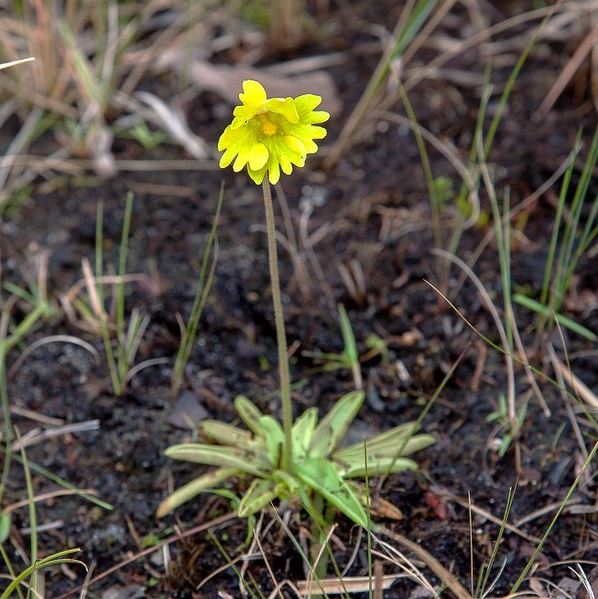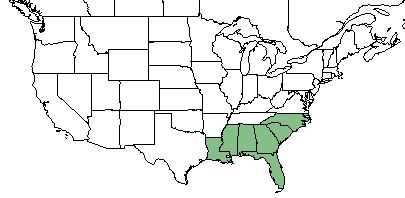Difference between revisions of "Pinguicula lutea"
Emmazeitler (talk | contribs) |
|||
| Line 25: | Line 25: | ||
==Description== | ==Description== | ||
<!-- Basic life history facts such as annual/perrenial, monoecious/dioecious, root morphology, seed type, etc. --> | <!-- Basic life history facts such as annual/perrenial, monoecious/dioecious, root morphology, seed type, etc. --> | ||
| − | ''P. lutea'' is a perennial | + | ''P. lutea'' is a terrestrial, scapose, perennial herb with a basal rosette. The leaves are rounded and entire, with a cuneate base, 1-6.5 cm long, and 0.8-2 cm wide. There are 1-8 scapes, glandular-pubescent, and 1-5 dm tall. The flower is solitary and ebracteate. The calyx is synsepalous near the base with 5, rarely 4 lobes. It is 4.5-6.5 mm long, glandular-pubescent, lobes 2.5-4.5 mm long. The corolla is yellow, 2-lipped, and 2-3.5 cm long. There are 5 lobes up to 1 cm long, spreading, and tubular throat. The capsules are globose or subglobose, longitudinally dehiscent, 3-4.5 mm in diameter. The seeds are brown, cancellate, oblong, and frequently acute at one end |
==Distribution== | ==Distribution== | ||
| − | ''P. lutea'' | + | ''P. lutea'' ranges from southeastern North Carolina to southern Florida, then west to eastern Louisiana.<ref name="weakley">Weakley, A.S. 2015. Flora of the southern and mid-atlantic states. Working Draft of 21 May 2015. University of North Carolina at Chapel Hill, Chapel Hill, North Carolina.</ref> |
==Ecology== | ==Ecology== | ||
| Line 34: | Line 34: | ||
''P. lutea'' can be found in pine savannas and wet pine flatwoods, mostly in the outer Coastal Plain, rarely extending inland to seepages and sandhill-pocosin ecotones in the fall-line Sandhills of SC. <ref name= "Weakley 2015"> Weakley, A. S. (2015). Flora of the Southern and Mid-Atlantic States. Chapel Hill, NC, University of North Carolina Herbarium. </ref> Specimens have been collected from wet sands of shrub bog, low swampy ground, borders of a bay, low pine woods, wet prairie, roadside ditch, savanna ecotone, pine savanna, grassy savanna, pine flatwoods, longleaf pine wiregrass ridge, edge of swamp, and open pineland.<ref name = "FSU herbarium"> URL: http://herbarium.bio.fsu.edu. Last accessed: June 2018. Collectors: Robert Kral, Robert K. Godrey, C.Jackson, S.R. Harrison, Delzie Demaree, Sidney McDaniel, R.M.S., S.W. Leonard, George Cooley, Joseph Monachino, Kathy Craddock Burks, Steve L. Orzell, Edwin L. Bridges, Luis Almodovvar, Elmar C. Prichard, Grady Reinert, Rosalind Thebaud, O. Lakela, S.C. Hood, Josephine Skehan, R.L. Wilbur, Clarke Hudson, Paul Lemon, W.P Adams, N.C. Henderson, F.S. Earle, Rodie White, Julie Neel, R. Komarek, M. Davis, Thomas E. Miller, Amanda Sang. States and counties: Florida (Liberty, Leon, Walton, Jefferson, Jackson, Gulf, Franklin, Pasco, Levy, martin, Clay, Volusia, Orange, St. Johns, Wakulla, Bay, Calhoun, Polk, Okaloosa, Santa Rosa, Washingotn) Georgia (Thomas, Grady, Berrien) Mississippi (Leon, Forrest, George, Jackson) North Carolina (Columbus) South Carolina (Charleston) Alabama (Baldwin)</ref> | ''P. lutea'' can be found in pine savannas and wet pine flatwoods, mostly in the outer Coastal Plain, rarely extending inland to seepages and sandhill-pocosin ecotones in the fall-line Sandhills of SC. <ref name= "Weakley 2015"> Weakley, A. S. (2015). Flora of the Southern and Mid-Atlantic States. Chapel Hill, NC, University of North Carolina Herbarium. </ref> Specimens have been collected from wet sands of shrub bog, low swampy ground, borders of a bay, low pine woods, wet prairie, roadside ditch, savanna ecotone, pine savanna, grassy savanna, pine flatwoods, longleaf pine wiregrass ridge, edge of swamp, and open pineland.<ref name = "FSU herbarium"> URL: http://herbarium.bio.fsu.edu. Last accessed: June 2018. Collectors: Robert Kral, Robert K. Godrey, C.Jackson, S.R. Harrison, Delzie Demaree, Sidney McDaniel, R.M.S., S.W. Leonard, George Cooley, Joseph Monachino, Kathy Craddock Burks, Steve L. Orzell, Edwin L. Bridges, Luis Almodovvar, Elmar C. Prichard, Grady Reinert, Rosalind Thebaud, O. Lakela, S.C. Hood, Josephine Skehan, R.L. Wilbur, Clarke Hudson, Paul Lemon, W.P Adams, N.C. Henderson, F.S. Earle, Rodie White, Julie Neel, R. Komarek, M. Davis, Thomas E. Miller, Amanda Sang. States and counties: Florida (Liberty, Leon, Walton, Jefferson, Jackson, Gulf, Franklin, Pasco, Levy, martin, Clay, Volusia, Orange, St. Johns, Wakulla, Bay, Calhoun, Polk, Okaloosa, Santa Rosa, Washingotn) Georgia (Thomas, Grady, Berrien) Mississippi (Leon, Forrest, George, Jackson) North Carolina (Columbus) South Carolina (Charleston) Alabama (Baldwin)</ref> | ||
===Phenology=== <!--Timing off flowering, fruiting, seed dispersal, and environmental triggers. Cite PanFlora website if appropriate: http://www.gilnelson.com/PanFlora/ --> | ===Phenology=== <!--Timing off flowering, fruiting, seed dispersal, and environmental triggers. Cite PanFlora website if appropriate: http://www.gilnelson.com/PanFlora/ --> | ||
| − | ''P. lutea'' | + | ''P. lutea'' flowers from late March through May.<ref name="weakley">Weakley, A.S. 2015. Flora of the southern and mid-atlantic states. Working Draft of 21 May 2015. University of North Carolina at Chapel Hill, Chapel Hill, North Carolina.</ref> |
<!--===Seed dispersal===--> | <!--===Seed dispersal===--> | ||
<!--===Seed bank and germination===--> | <!--===Seed bank and germination===--> | ||
Revision as of 14:50, 17 November 2020
Common name: yellow butterwort [1]
| Pinguicula lutea | |
|---|---|

| |
| Photo by John B hosted at Bluemelon.com/poaceae | |
| Scientific classification | |
| Kingdom: | Plantae |
| Division: | Magnoliophyta - Flowering plants |
| Class: | Magnoliopsida - Dicots |
| Order: | Schrophulariales |
| Family: | Lentibulariaceae |
| Genus: | Pinguicula |
| Species: | P. lutea |
| Binomial name | |
| Pinguicula lutea Walter | |

| |
| Natural range of Pinguicula lutea from USDA NRCS Plants Database. | |
Contents
Taxonomic Notes
Synonyms: none
Varieties: none
Description
P. lutea is a terrestrial, scapose, perennial herb with a basal rosette. The leaves are rounded and entire, with a cuneate base, 1-6.5 cm long, and 0.8-2 cm wide. There are 1-8 scapes, glandular-pubescent, and 1-5 dm tall. The flower is solitary and ebracteate. The calyx is synsepalous near the base with 5, rarely 4 lobes. It is 4.5-6.5 mm long, glandular-pubescent, lobes 2.5-4.5 mm long. The corolla is yellow, 2-lipped, and 2-3.5 cm long. There are 5 lobes up to 1 cm long, spreading, and tubular throat. The capsules are globose or subglobose, longitudinally dehiscent, 3-4.5 mm in diameter. The seeds are brown, cancellate, oblong, and frequently acute at one end
Distribution
P. lutea ranges from southeastern North Carolina to southern Florida, then west to eastern Louisiana.[2]
Ecology
Habitat
P. lutea can be found in pine savannas and wet pine flatwoods, mostly in the outer Coastal Plain, rarely extending inland to seepages and sandhill-pocosin ecotones in the fall-line Sandhills of SC. [3] Specimens have been collected from wet sands of shrub bog, low swampy ground, borders of a bay, low pine woods, wet prairie, roadside ditch, savanna ecotone, pine savanna, grassy savanna, pine flatwoods, longleaf pine wiregrass ridge, edge of swamp, and open pineland.[4]
Phenology
P. lutea flowers from late March through May.[2]
Fire ecology
P.. lutea will re-sprout after a fire. It has been observed 40 days after a burn in a mesic pine savanna with a small depression marsh. [5]
Conservation and Management
P. lutea is listed as threatened by the Florida Department of Agriculture & Consumer Services Division of Plant Industry. [1]
Cultivation and restoration
Photo Gallery
References and notes
- ↑ 1.0 1.1 Cite error: Invalid
<ref>tag; no text was provided for refs namedUSDA Plant Database - ↑ 2.0 2.1 Weakley, A.S. 2015. Flora of the southern and mid-atlantic states. Working Draft of 21 May 2015. University of North Carolina at Chapel Hill, Chapel Hill, North Carolina.
- ↑ Weakley, A. S. (2015). Flora of the Southern and Mid-Atlantic States. Chapel Hill, NC, University of North Carolina Herbarium.
- ↑ URL: http://herbarium.bio.fsu.edu. Last accessed: June 2018. Collectors: Robert Kral, Robert K. Godrey, C.Jackson, S.R. Harrison, Delzie Demaree, Sidney McDaniel, R.M.S., S.W. Leonard, George Cooley, Joseph Monachino, Kathy Craddock Burks, Steve L. Orzell, Edwin L. Bridges, Luis Almodovvar, Elmar C. Prichard, Grady Reinert, Rosalind Thebaud, O. Lakela, S.C. Hood, Josephine Skehan, R.L. Wilbur, Clarke Hudson, Paul Lemon, W.P Adams, N.C. Henderson, F.S. Earle, Rodie White, Julie Neel, R. Komarek, M. Davis, Thomas E. Miller, Amanda Sang. States and counties: Florida (Liberty, Leon, Walton, Jefferson, Jackson, Gulf, Franklin, Pasco, Levy, martin, Clay, Volusia, Orange, St. Johns, Wakulla, Bay, Calhoun, Polk, Okaloosa, Santa Rosa, Washingotn) Georgia (Thomas, Grady, Berrien) Mississippi (Leon, Forrest, George, Jackson) North Carolina (Columbus) South Carolina (Charleston) Alabama (Baldwin)
- ↑ Observation by Edwin Bridges in Highlands County, Fl, December 28, 2015, posted to Florida Flora and Ecosystematics Facebook Group.